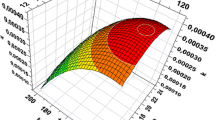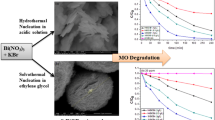Abstract
Zinc oxide is a versatile semiconductor material, widely used for its electronic and photocatalytic properties. In this work, we report a response-surface investigation of a simple technique for the immobilization of nanosized ZnO powder onto 5.0-mm glass beads. The nanoparticles are suspended in ultrapure water, and the glass beads are immersed in this suspension under vigorous stirring. The beads are removed from the suspension and calcined, after which a ZnO layer is formed on their surface. Using a modified response-surface methodology (modified Doehlert design), we investigated the effect of the nominal ZnO suspension concentration, the annealing temperature and the number of coating rounds on the amount of ZnO fixed onto the substrates and on the photocatalytic performance of the resulting films under visible light. Our results show that the coated beads have good photocatalytic activity, being able to remove up to 50% of a load of acetaminophen (used as a model contaminant) from a 5.0 ppm solution under simulated solar irradiation. We present and discuss the effects of temperature and precursor concentration, shown to be statistically significant only to a certain extent; limited to the number of coating rounds.







Similar content being viewed by others
Availability of data and material
The data that support the findings of this study are available from the corresponding author, upon reasonable request.
Code availability
Not applicable.
References
Alhaji MH, Sanaullah K, Khan A, Hamza A, Muhammad A, Ishola MS, Rigit ARH, Bhawani SA (2017) Int J Environ Sci Technol 14:2039
Behrens SH, Grier DG (2001) J Chem Phys 115:6716
Bohnke O, Bohnke C, Donnadieu A, Davazoglou D (1988) J Appl Electrochem 18:447
Cai Z, Liu B, Zou X, Cheng HM (2018) Chem Rev 118:6091
Chen Y, Dionysiou DD (2006) Appl Catal B Environ 62:255
da Silva GTST, Carvalho KTG, Lopes OF, Gomes ES, Malagutti AR, Mastelaro VR, Ribeiro C, Mourão HAJL (2017) ChemCatChem 9:3795
Dalida MLP, Amer KMS, Su CC, Lu MC (2014) Environ Sci Pollut Res 21:1208
Degen A, Kosec M (2000) J Eur Ceram Soc 20:667
Djurišić AB, Chen X, Leung YH, Ng AMC (2012) J Mater Chem 22:6526
Doehlert DH (1970) Appl Stat 19:231
Gar Alalm M, Tawfik A, Ookawara S (2015) J Water Process Eng 8:55
Gaya UI (2014) Heterogeneous photocatalysis using inorganic semiconductor solids. Springer, Berlin, p 9789400777
Gogate PR, Pandit AB (2004) Adv Environ Res 8:553
Gotostos MJN, Su CC, De Luna MDG, Lu MC (2014) J Environ Sci Heal Part A 49:892
Kansal SK, Singh M, Sud D (2007) J Hazard Mater 141:581
Kihara K, Donnay G (1985) Can Miner 23:647
Klingshirn CF (2007) ChemPhysChem 8:782
Lee KM, Lai CW, Ngai KS, Juan JC (2016) Water Res 88:428
Manassero A, Satuf ML, Alfano OM (2017) Chem Eng J 326:29
Meille V (2006) Appl Catal A Gen 315:1
Meulenkamp EA (1998) J Phys Chem B 102:5566
Nijhuis TA, Beers AEW, Vergunst T, Hoek I, Kapteijn F, Moulijn JA (2001) Catal Rev Sci Eng 43:345
Omar FM, Aziz HA, Stoll S (2014) Sci Tot Environ 3:1
Pereira CDS, Maranho LA, Cortez FS, Pusceddu FH, Santos AR, Ribeiro DA, Cesar A, Guimarães LL (2016) Sci Total Environ 548–549:148
Ramos B, Ookawara S, Matsushita Y, Yoshikawa S (2014) J Environ Chem Eng 2:1487
Ramos B, Ookawara S, Matsushita Y, Yoshikawa S (2015) J Environ Chem Eng 3:681
Sadik OA, Du N, Yazgan I, Okello V (2014) Nanostructured membranes for water purification, 2nd edn. Elsevier Inc, Asmterdam
Soufi J, Pastor-Franco M, Zhou S, Hardala R, Houillon F, Meille V, Richard D (2016) Part Sci Technol 34:229
Srikanth B, Goutham R, Narayan R, Ramprasath A, Gopinath KP, Sankaranarayanan AR (2017) J Environ Manag 200:60
Tang F, Uchikoshi T, Sakka Y (2002) J Am Ceram Soc 85:2161
Widati AA, Nuryono N, Kartini I (2019) AIMS Mater Sci 6:10
Yu J, Pan Y, Wang C, Lai Z (2016) Chem Eng Sci 141:119
Acknowledgements
The authors acknowledge the financial support of the Sao Paulo Research Foundation (FAPESP grants #2015/21421-0 and #2018/21271-6) and the Coordination for the Improvement of Higher Education Personnel – Brasil (CAPES/PROCAD). The authors also thank the technical support of Dr FJ Trindade and the Multiuser Analytical Center of the Federal University of ABC (UFABC).
Funding
This work was supported by the Sao Paulo Research Foundation (FAPESP Grants 2015/21421-0 and 2018/21271-6), by the National Council of Scientific and Technological Development (CNPq grant 311230/2020-23), and by the Coordination for the Improvement of Higher Education Personnel–Brasil (CAPES/PROCAD).
Author information
Authors and Affiliations
Contributions
BR: Conceptualization, methodology, data curation, formal analysis, writing – original draft; AOGS: Methodology, investigation; ACSCT: Supervision, project administration, funding acquisition, writing.
Corresponding author
Ethics declarations
Conflict of interest
The authors declare no competing interests.
Additional information
Publisher's Note
Springer Nature remains neutral with regard to jurisdictional claims in published maps and institutional affiliations.
Rights and permissions
About this article
Cite this article
Ramos, B., Silva, A.O.G. & Teixeira, A.C.S.C. Immobilization of ZnO nanoparticles onto glass spheres: effects of annealing temperature, zinc oxide concentration, and number of coating rounds on the photocatalytic activity under visible light. Braz. J. Chem. Eng. 39, 403–414 (2022). https://doi.org/10.1007/s43153-021-00160-z
Received:
Revised:
Accepted:
Published:
Issue Date:
DOI: https://doi.org/10.1007/s43153-021-00160-z




